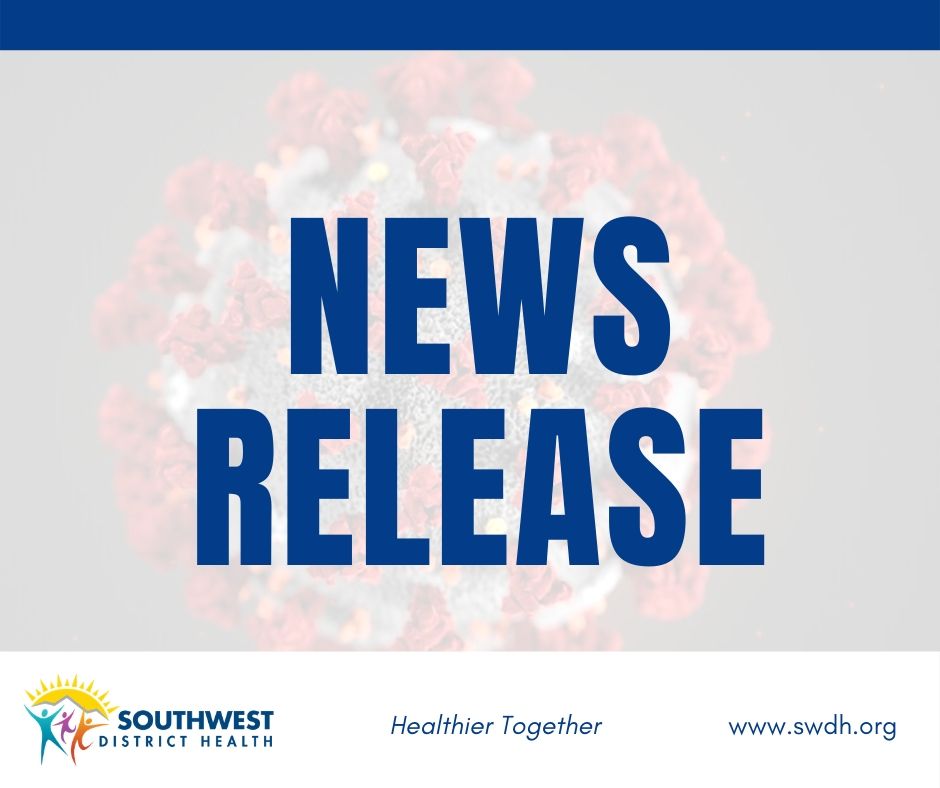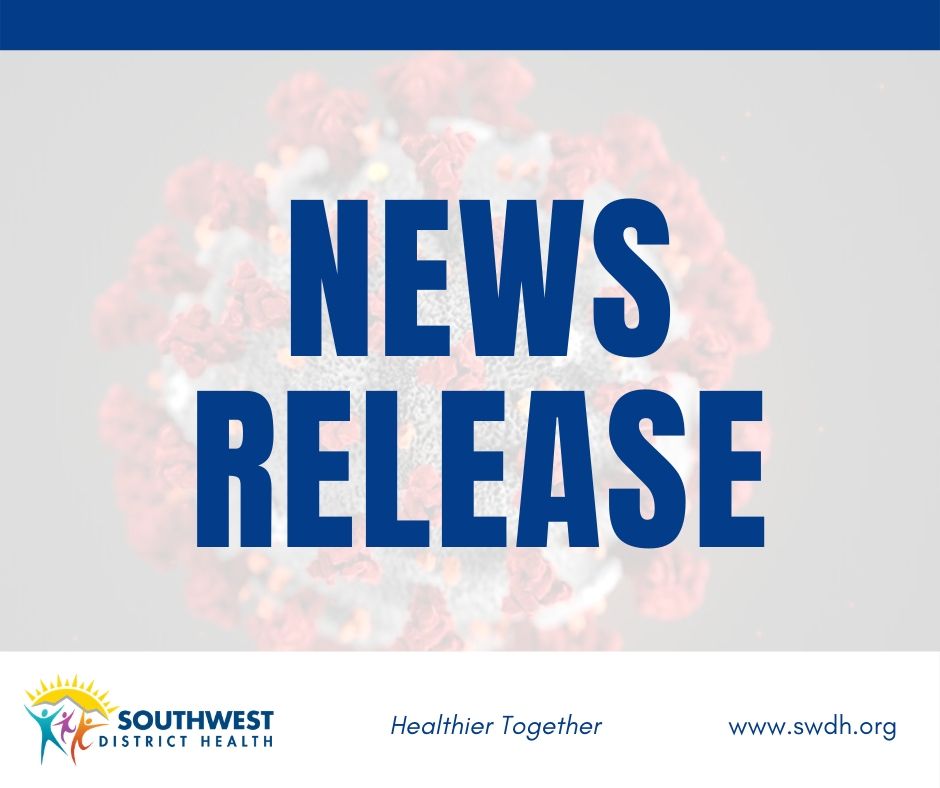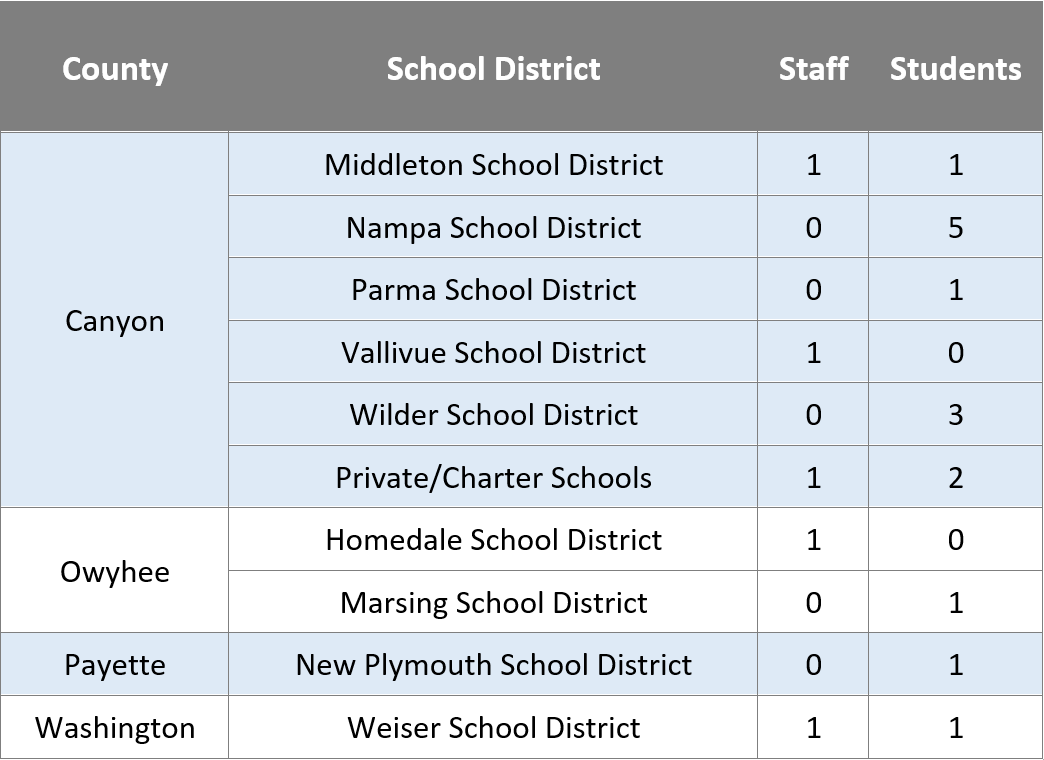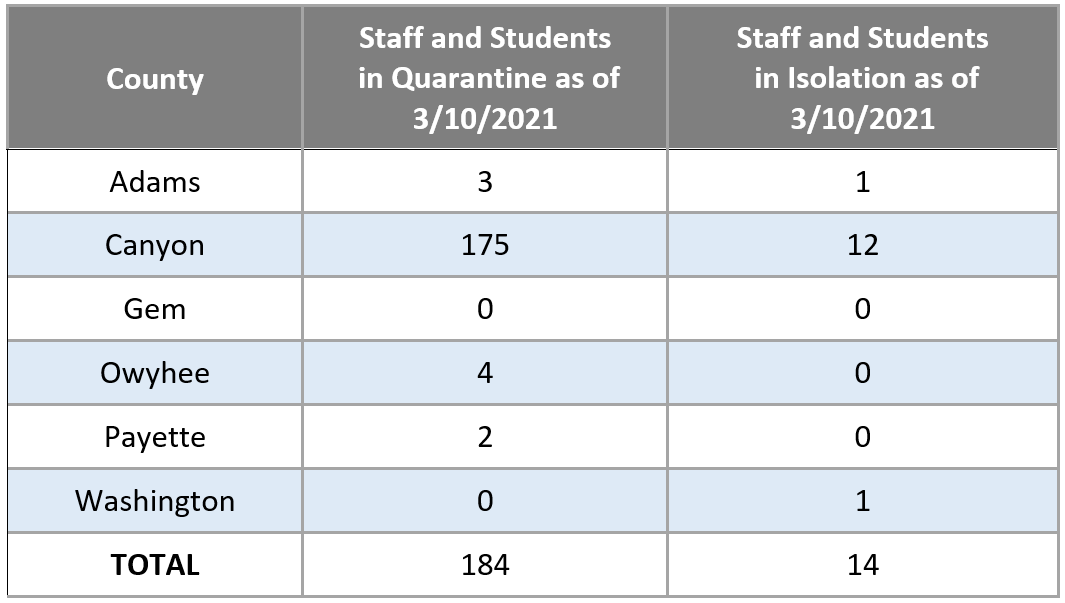FOR IMMEDIATE RELEASE
Southwest District Health Jurisdiction Continues Declining Daily Incidence Rates; Anticipated Changes to Health Alert Level Data Metrics Following Board of Health Meeting
CALDWELL, IDAHO – Southwest District Health (SWDH) continues to see declining daily incidence rates and decreasing positivity rates based on data available for the date range February 28, 2021 – March 13, 2021. The health alert designation for the six counties remains unchanged from the previous two weeks. Adams, Gem, Payette, and Washington counties are at the gray COVID-19 health alert level. Canyon County and Owyhee County are at the yellow health alert level. As of March 13, 2021, the daily district-wide incidence rate per 10,000 population is 0.929.
On Tuesday, March 16, 2021, SWDH Board of Health approved changing the metrics in determining COVID-19 health alert levels for counties within its six-county jurisdiction. The metrics approved at this meeting are not reflected in this weeks’ county health alert level update but will be adopted for future health alert level updates. The changes include adjustments to the case fatality rate and hospitalization rate metrics, removal of the access to testing, known source, and elected officials input metrics, and addition of vaccination rate by county metric.
The information used in determining county health alert levels is provided below.
ADAMS COUNTY Health Alert Level: Gray
Adams County will remain in the gray health alert level, with a decreasing daily incidence rate and low positivity rate. Adams County saw a daily COVID-19 incidence of 0.366 daily new cases per 10,000 people and a positivity rate of 2.50%. Only two cases were reported in Adams County during this two-week range. In efforts to protect the confidentiality of these individuals, the Adams County Health Alert Level Dashboard will not be publicly available this week.
CANYON COUNTY Health Alert Level: Yellow
Canyon County will remain in the yellow health alert level with a low daily incidence rate and positivity rate, and with multiple cluster outbreaks within schools. Canyon County has a daily incidence rate of 1.01 daily new cases per 10,000 people which is steadily decreasing. Canyon County has a positivity rate of 4.21%, which increased slightly but still meets our goal of 5.00% or less. Only 60.67% of COVID-19 cases have reported knowing where they were exposed, which points to sustained community spread. SWDH investigators are seeing cases exposed through social gatherings, workplaces and households. Six congregate living facilities are reporting cluster outbreaks.[1] Multiple schools in Canyon County are reporting cluster outbreaks, with transmission occurring within the schools.
GEM COUNTY Health Alert Level: Gray
Gem County will remain in the gray health alert level, due to a decreasing daily incidence rate and positivity rate. Gem County has a daily incidence rate of 0.36 daily cases per 10,000 people which is decreasing. The test positivity rate for Gem County is 2.48% which is decreasing and meets our goal of 5.00% or less. No congregate care facilities in Gem County are facing sustained COVID-19 outbreaks. 50.00% of new cases that were contacted knew where they were exposed to COVID-19, which is decreasing and indicates community transmission. Of the individuals who could identify their exposure source, most were attributed to workplaces or household exposure. No cases of COVID-19 were reported in Gem County.
OWYHEE COUNTY Health Alert Level: Yellow
Owyhee County will remain in the yellow health alert level this week, with an increasing daily incidence rate and positivity rate. Owyhee County currently has a daily incidence rate of 1.27 daily cases per 10,000 people, which is increasing. The test positivity rate is 7.41% which is increasing and does not meet our goal of 5.00% or less. 63.16% of cases can identify an exposure source, which is decreasing and indicates community transmission. SWDH epidemiologists are seeing cluster outbreaks in Owyhee County primarily from households and school exposure. One school in Owyhee County is reporting a cluster outbreak, with transmission occurring within the school.
PAYETTE COUNTY Health Alert Level: Gray
Payette County will remain in the gray health alert level, with a low daily incidence rate and positivity rate. Payette County has a daily incidence rate of 0.69 daily new cases per 10,000 people which is increasing slightly. Payette County has a test positivity rate of 1.75%, which is also increasing but still meets our goal of 5.00% or less. 61.11% of cases know where they were exposed to COVID-19, which is decreasing and indicates community transmission. Southwest District Health epidemiologists are seeing cluster outbreaks through workplaces and household exposure. Multiple sporadic, imported cases of COVID-19 were reported in Payette County schools, with no evidence of a cluster outbreak.
WASHINGTON COUNTY Health Alert Level: Gray
Washington County will remain in the gray health alert level, due to a low daily incidence rate, and positivity rate. Washington County currently has a daily incidence rate of 0.56 daily cases per 10,000 people, which increased slightly but is still very low. The positivity rate for Washington County is 2.35%, which is increasing but still meets our goal of 5.00% or less. 40.00% of cases in Washington County were able to identify a potential exposure source, which points to community transmission. One school is reporting sporadic, imported cases of COVID-19, with no evidence of a cluster outbreak.
[1] The incidence rate measures how many cases occur each day, and standardizes this value by population. SWDH measures the daily incidence rate per 10,000 population using the following calculation: daily confirmed and probable cases are averaged over the two-week period. This value is divided by the county population, and then multiplied by 10,000 to find the daily incidence per 10,000.
2 According to Idaho Department of Health and Welfare, “Long-term care facility means a nursing home, assisted living facility, or intermediate care facility. There are just over 400 long-term care facilities in Idaho. Outbreak means at least one lab-confirmed COVID-19-positive case associated with a facility.”
WEEKLY CASES BY SCHOOL DISTRICT
The following table represents data on confirmed and probable COVID-19 cases among students and staff attending in-person classes where investigations began between March 7, 2021 – March 13, 2021.
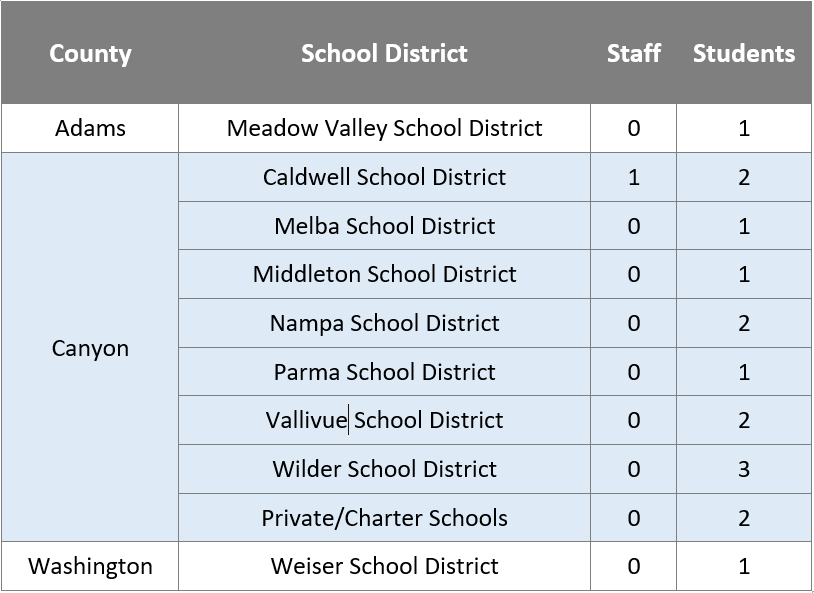
The following table represents data on the number of staff and students currently in quarantine and isolation on the day the data are pulled and may not account for individuals who have been released from quarantine or are just entering quarantine.
Those in quarantine have been identified as a close contact of a positive case and are being asked to stay home for 14 days to monitor for symptoms. Those in isolation are currently positive for COVID-19 and are asked to isolate away from others for a minimum of ten days from the onset of symptoms to prevent further spread of the infection.
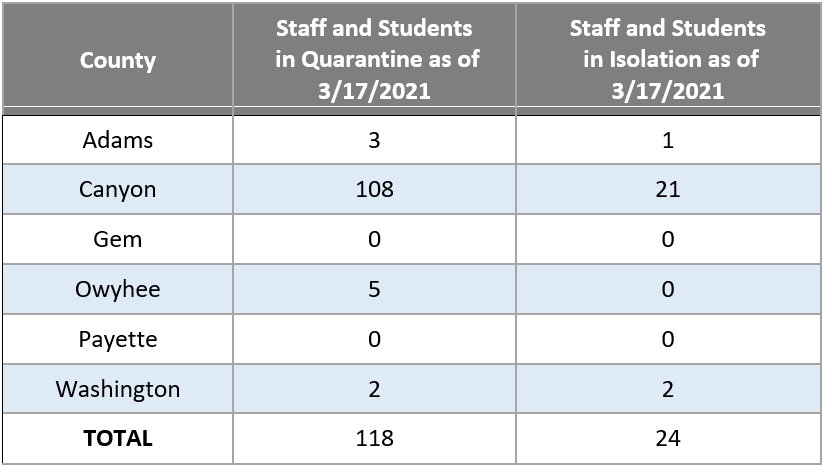
Region 3 data are available on the Southwest District Health website at https://swdh.id.gov/covid19/. Please visit https://coronavirus.idaho.gov/ for statewide information. Questions may be directed to the SWDH COVID-19 Call Center Monday through Friday from 8:30 a.m. to 4:30 p.m. (except for observed holidays) at 208-455-5411.
# # #
Media Contacts:
Ashley Anderson Ashley.Anderson@phd3.idaho.gov
Katrina Williams Katrina.Williams@phd3.idaho.gov
